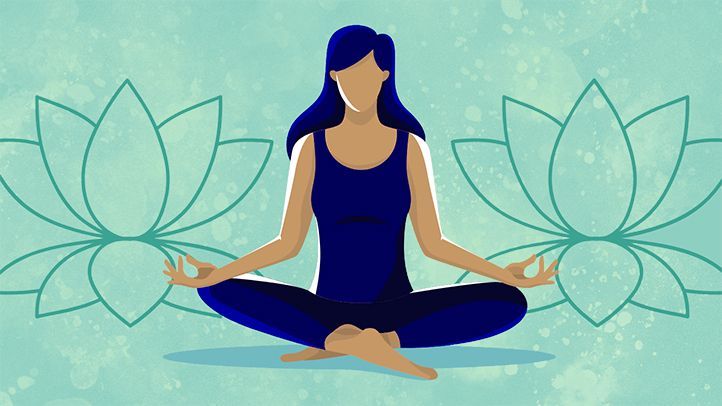You can instantly relax your body and mind with a guided visualization. It is enjoyable to practice, and it is not extremely challenging or daunting. It can also be a good tactic for maintaining your resilience through trying times. It can help you de-stress in minutes.
You can manage stress and release physical tension in your body quickly and simply with the help of guided imagery, a practical and easy relaxation technique. It is practically as simple as having a vivid daydream, and with practice, this method can enable you to tap into your inner wisdom.
You can discuss other techniques to manage stress with your healthcare provider.
What is the guided imagery technique?
One way to unwind stress is through a guided visualization. When someone uses guided imagery, he could conjure up moments, settings, or other things that make him feel calm and at ease.
The use of relaxation techniques is typically harmless for healthy individuals. Guided imagery is one relaxation technique that aims to activate the body’s natural relaxation response. The following physiological modifications could be part of this reaction:
- Slow respiration
- Low blood pressure
- Slow heart rate
How does using guided imagery for stress relief work?
Because of the relationship between the mind and body, guided imagery can give you the impression that you are actually feeling something even when you aren’t. When you visualize every aspect of a secure, pleasant location, such as a beach or garden, you may relax. It helps you get your emotions under control more wisely and leads to a peaceful mental state. You must give first aid in case of any mental health emergency. You would notice a positive and healthy change in your mood and health.
There are a few advantages to guided visualization for health:
- Efficiently and swiftly relaxes the body. Your body imparts a negative vibe when you are stressed. It could be in response to a real or imagined threat. However, by visualizing a serene scene, you may reassure your body that it is safe, which will quiet it down.
- Enhances sleep. Before going to bed, clear your mind of any undesirable pre-sleep thoughts by concentrating on something relaxing. You are able to fall asleep peacefully because of this mental clarity.
- Decreases the sense of ongoing pain. Researchers discovered in 2015 that stress makes the pain feel worse for the stressed person. By using guided imagery to relax, you can lessen the impact of chronic pain.
- Temporarily reduces the symptoms of depression and anxiety. You can momentarily escape the negative thought processes linked to anxiety and sadness by concentrating on soothing images. Although not a long-term fix, this can provide some much-needed relief.
- Lowers the amount of stress hormones. Your body releases adrenaline and cortisol when you are stressed, which raises your blood pressure and heart rate. Your brain can prevent the release of these hormones by using guided imagery.
- Helps you make a commitment to good habits. You can visualize the fruitful effects of your actions by using guided imagery. You will be more inclined to stick with a habit if you believe in its advantages.
Different stress-reduction methods will have different effects on different people. The coaches for meditation can assist you in locating a solution that works for you. They can pinpoint your stress triggers through private, one-on-one sessions and develop a strategy to deal with them.
How is guided imagery performed?
Use these steps to give guided imagery a try:
- Locate a pleasant spot to sit or lie down. Shut your eyes.
- Just a few slow, deep breaths at first can help you unwind.
- Imagine a serene and tranquil environment. You can choose a beach, a mountain setting, a meadow, or another scene for this.
- Try to visualize the setting and add some specifics. Is there, for instance, a breeze? It feels like what? How do you feel? How does the sky appear? Is it cloudy or is it clear?
- A path is a good addition to your setting. You can choose a specific path with the addition of some greenery, like trees and flowers. You feel more at ease as you continue along the path deeper into the meadow.
- Take a few minutes to breathe slowly and soak in the peace when you are relaxed and really immersed in your scene.
- Consider a straightforward term or sound that you can use later to guide you back to this location. When you are prepared, slowly exhale from the scene and return to the present. Tell yourself that you will feel refreshed and at ease, and that you will carry your serenity with you.
- Open your eyes after the third count. Take note of your current feelings.
Having an instructor or audio recording to listen to could be beneficial. Although you can utilize a script (a collection of written instructions), it is possible that hearing the directions may help you feel more at ease during the procedure.
Conclusion
People can employ guided imagery as a method of relaxation to lower stress and improve well-being.
Usually, it entails visualizing calm situations, things, or scenes. The body should respond to guided visualization by becoming more relaxed naturally.
Although guided imagery poses a few hazards, it may make some people feel more anxious.
It is crucial to speak with a top psychiatrist before using this technique if you feel depressed, stressed, or worried.
FAQS
1. What is the purpose of guided imagery?
Using guided visualization has several benefits. You can use it to encourage relaxation, which helps lessen other stress-related issues and improve blood pressure. Additionally, you can use it to control pain and encourage healing while working towards goals (such as stopping smoking or losing weight).
2. How does guided imagery reduce pain?
According to guided imagery, your brain might be able to experience pain alleviation if you can picture your pain leaving your body. The goal of guided visualization is to reduce sympathetic nervous system activity.
3. How does guided imagery include the senses?
Through guided imagery, you can transport your mind to a location that you would prefer to be by using your imagination and all five senses (seeing, smell, touch, taste, and hearing).




